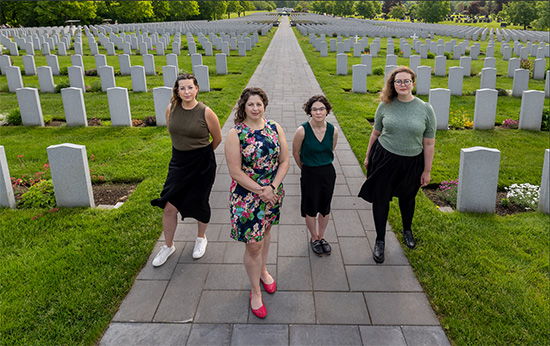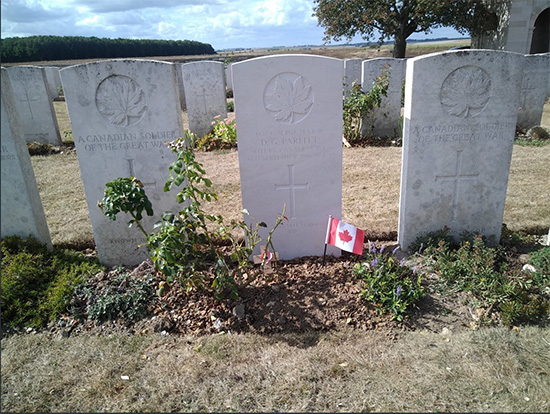Meet the team that helps to identify the CAF’s fallen members
October 14, 2025 - Defence Stories
Estimated read time – 2:00

Caption
The Casualty Identification Program team. From left to right: Renée Davis, Dr. Sarah Lockyer, Dr. Melissa Davidson and Alexandra McKinnon. (Beechwood Cemetery, Ottawa, Ontario)
Photo credit: Len Wagg.
In June, the Department of National Defence and the Canadian Armed Forces identified a Canadian soldier’s grave from the First World War. Behind the identification of Captain (Capt) William Webster Wilson, and of other unknown service members is a four-person team—a forensic anthropologist and three historians.
“The job is a borderless puzzle,” said Dr. Sarah Lockyer, the Casualty Identification Coordinator. “It doesn't work in a linear process.”
Dr. Lockyer, Renée Davis, Alexandra McKinnon, and Dr. Melissa Davidson work in the Directorate of History and Heritage’s Casualty Identification Program. The program identifies fallen and missing service members from the First World War, the Second World War, and the Conflict in Korea.
There are two types of cases the team investigates—the identification of human remains and the identification of graves.
In the first type of case, Lockyer does a forensic analysis of the newly discovered human remains to find any useful information such as height and age.
Meanwhile, using documents like war diaries, Davis, McKinnon, and Davidson do different types of historical research.
Davidson believes it's more than just looking at a list of people. “It's really about putting a story to that person, regardless of what their name is,” she said.
When they have a clearer picture, McKinnon, a historian, searches through the members’ family trees for DNA donors.
“It’s about finding connections and really, this is like detective work,” she continued.
Once the team is sure of the service member’s identity, they present a report to the Casualty Identification Review Board, which includes organisations such as Veterans Affairs Canada and the Commonwealth War Graves Commission.

Caption
Graves of Canadian soldiers who died in the First World War. (Regina Trench Cemetery, Grandcourt, France).
Photo credit: Sarah Lockyer
Capt Wilson’s case was solved differently. There were no human remains to start off the search—only the grave of an unknown soldier. These ‘grave cases’ rely on historical work and often the efforts of independent researchers who have access to local archives, cemeteries, churches, and other areas.
Davis oversees graves cases. She feels a connection to the service members she’s helping to identify.
“You feel like that person is almost a distant relative of yours, and you really want to see it get to that point where you can put their name on the headstone. So, you really feel this deep-seated connection,” Davis explains.
The Casualty Identification Program has identified the human remains of 36 Canadians and 12 unknown graves since its creation in 2007. There are currently 42 active investigations involving remains and 44 cases involving graves.
If you are related to a Canadian service member who is missing from one of the conflicts mentioned above, the Casualty Identification Program wants to hear from you.